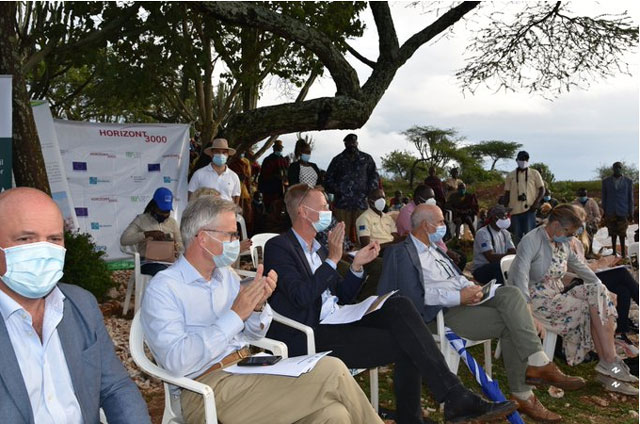
In response, last October, the Japanese government contributed US$ 0.6 million (Shs2.2 billion) to help WFP provide 244 metric tonnes of enriched foods to 26,000 children aged below five, pregnant women and new mothers in the worst hit Moroto and Napak districts for at least three months to stop overall malnutrition levels increasing.
But the government and its partners say they have now come up with a more robust project to cure the region’s eternal food problem. As part of the Pro-ACT project, the EU is contributing to WFP’s lean season response by providing a protective ration.
“We are working with the government to build an effective early warning system for Karamoja that will predict in time, food security shocks, and then support government and communities to prepare accordingly. “Timeliness is of the essence,” said Priya Gujadhur; the FAO’s Deputy Representative in Uganda.
Gujadhur emphasized the importance of strengthening the capacity of national and local stakeholders.
“Early identification of risks linked to clear action will reduce the impact of food security shocks before needs peak,” she said.
“Providing people with the information and skills they need to prepare is the most effective way of reducing humanitarian needs over time. Zero hunger is possible only if communities have the right tools to manage shocks,” said Ryan Anderson, the WFP Deputy Country Director in Uganda.
“WFP is providing assistance to only a fraction of the people who need it in Karamoja. The frequency and severity of natural hazards in Uganda is only going to get worse with climate change and the number of people in need will grow. We must be smarter in the way we respond to shocks.”
The protective ration is assistance that will help reduce the likelihood of sharing specialized nutritious food that is meant for treatment of malnutrition in children under five and pregnant and breastfeeding women.
An essential part of Pro-ACT is strengthening the District Disaster Management Committees to develop contingency plans that address the needs of communities. Attilio Pacifici, the European Union Head of Delegation in Uganda appreciated the government of Uganda for being at the forefront of all development and emergency programmes in the country.
“Local and national stakeholders will increase their capacity to share timely and accurate information that will support communities to prepare for and manage shocks. This action will also contribute to ongoing policy dialogue on Disaster Risk Financing and the Disaster Risk Management legal framework,” he said.
“Without government, interventions, especially those that address climate disasters, would not be sustainable. That is why Pro-ACT supports national and local authorities with the resources they need to plan and deliver responses that effectively meet the needs of the people.”
Meanwhile, it is not the first time Karamoja is getting funding to develop an Early Warning System. FAO has already piloted a drought early warning system to improve community preparation for the lean season and other cyclic shocks that affect food security.
The USAID, the United States Agency for International Development (USAID), has been running the Famine Early Warning System Network (FEWSNET), a programme that forecasts food insecurity in eastern Africa since 1985.
In 2013, the European Humanitarian Aid and Civil Protection (ECHO) in Karamoja and North Pokot was launched to help the Karimojong of Uganda and the Pokot of Kenya respond appropriately to persistent droughts.
The project was run by a consortium of non-profit organisations; including the International Institute for Cooperation and Development (C&D) alongside the Agency for Technical Cooperation (ACTED) under the guidance by DanChurchAid, a Danish NGO that has been implementing humanitarian and development projects in Uganda for the last 30 years.
But a Karimojong youth who works in one of the numerous NGOs that work in Karamoja told The Independent on Sept. 03 that Karamoja has one big problem which the government and donors needs to solve: water.
“Without this, subsistence agriculture cannot replace pastoralism and its ‘gun economy,’” he told The Independent, “The idea of surviving on subsistence has nurtured the gun culture in the sub-region. People look for guns to protect their wealth because they don’t have insurance or NSSF.”
“The people of Karamoja have been trying to transition from pastoralism to settled agriculture for many years now but many of them are easily frustrated by the harsh climate there,” he said.
To put Karamoja’s water problem into perspective, he said the sub-region receives the same amount of rain as Kampala but it is not distributed throughout the year as it happens in Kampala and the surrounding districts.
“It falls intensely and in short spells and it disappears. So crops do not yield as much and farmers easily get fed up.”
He thinks the government’s proposition to have a man-made lake in the sub-region could go a long way in curing Karamoja’s perennial food crisis.
This, he says, could kick-start mechanized agriculture in Karamoja’s fertile green belt districts of Nakapiripirit, Nabilatuk, Napak, Moroto and Kaabong.
****
 The Independent Uganda: You get the Truth we Pay the Price
The Independent Uganda: You get the Truth we Pay the Price



